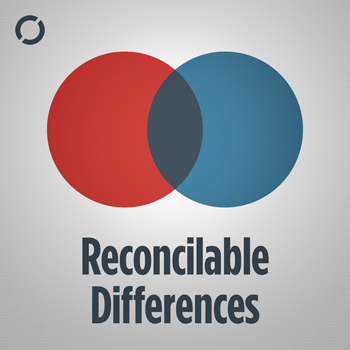Support this show
Get an ad-free version of the show, plus a monthly extended episode.#72: The Seventh Alarm Clock
February 22nd, 2018 · 108 minutes
This week's main topic: "What If Productivity, but Too Much?" In the pursuit of efficiency and professional development, how do you know when you’ve gone too far? And what are the downsides when you do?
This episode of Reconcilable Differences is sponsored by:
- Squarespace: Make your next move. Enter offer code DIFFS at checkout to get 10% off your first purchase.
- Mack Weldon: Smart underwear for smart guys. Get 20% off with the code DIFFS.
- Fracture: Photos printed in vivid color directly on glass. Use code DIFFS for 15% off.
Stream this episode
Links and Show Notes
This week kicks off with recalibrating some expectations and repeatedly clicking some buttons. Merlin likes dog shopping and dislikes that dumb Winston Churchill movie.
In follow-up, John scores a monarchical point to listener, "swilliams," and Merlin likes Parliamentary questions. In an accidental nano-topic, your hosts discuss the decline of Shame. In further follow-up, John has some more tips on getting the lyrics right.
In this week’s mini-topic, John has some pointed questions about Merlin’s quote-unquote Caffeine Addiction. Is Merlin a Fake Migraine Girl? John still doesn’t like coffee, and Merlin is weirdly protective about his eyeglasses. Much like the great John Hurt. This leads to a broader discussion of addiction, focusing on how smoking used to be much more of a thing.
(Recorded on Tuesday, January 30, 2018.)
Results - Truth Tobacco Industry Documents
Thinking, Fast and Slow - Wikipedia
The central thesis is a dichotomy between two modes of thought: "System 1" is fast, instinctive and emotional
Daniel Kahneman - Wikipedia
Daniel Kahneman (/ˈkɑːnəmən/
Minimax - Wikipedia
Minimax (sometimes MinMax or MM[1]) is a decision rule used in decision theory, game theory, statistics and philosophy for minimizing the possible loss for a worst case (maximum loss) scenario. When dealing with gains, it is referred to as "maximin"—to maximize the minimum gain. Originally formulated for two-player zero-sum game theory, covering both the cases where players take alternate moves and those where they make simultaneous moves, it has also been extended to more complex games and to general decision-making in the presence of uncertainty.
5by5 | Back to Work #1: Alligator in the Bathroom
In the inaugural episode of Back to Work, Merlin Mann and Dan Benjamin discuss why they’re doing this show, getting back to work instead of buying berets, the lizard brain, and compare the Shadow of the Mouse to San Francisco, and eventually get to some practical tips for removing friction.
